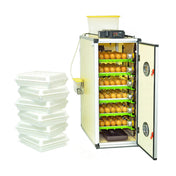Table of Content
- Choosing the Best Breeds for Meat Chickens
- Caring for Meat Birds
- Hatching and Raising Your Meat Birds
- How to Process Meat Chickens: A Step-by-Step Guide
- Common Mistakes to Avoid When Raising Meat Chickens
- Quick Q&A
Chickens are great for more than just eggs. Depending on the size of your homestead and coop options, you can upgrade your sustainability by including meat birds too! From Cornish Cross to Buckeye chickens, we’ll cover the best breed options and explain why they might be right for you.
Raising chickens for meat is a great way to live sustainably and provide your family with locally grown, nutritious protein. Home-raised chickens taste better than store-bought ones and enjoy a more natural life with fresh air, sunlight, grass, and bugs. If you're exploring the broader benefits, learn more about why raising poultry is a valuable addition to any homestead or backyard setup. If you're new to raising meat chickens, don’t worry! HatchingTime offers egg incubator , hatchers, and starter kits for all levels of poultry keeping.
Choosing the Best Breeds for Meat Chickens
While you have hundreds of chicken varieties to choose from for eggs, meat birds come from a more limited pool. You can choose from meat breeds like Cornish and Bresse, dual-purpose breeds like Jersey Giant, Australorp, Orpington, Rhode Island Red, and Plymouth Rock, or commercial hybrids like Cornish Cross (supermarket chicken), Red Rangers, Sasso, and Kosher Kings.
Cornish Cross is the most popular meat breed. These chickens grow rapidly, reaching 10–12 pounds in just six weeks, and boast an exceptional feed-to-meat ratio. Their genetics favor plump breasts, thick thighs, and a fat layer that keeps meat juicy—perfect for roasting or grilling. Ideal for small farms or homesteads, they deliver high-quality meat quickly and affordably, outperforming heritage breeds in efficiency.
Freedom Ranger chickens offer a great pasture-raised alternative. They thrive on low-protein feed and forage naturally, cutting down on commercial feed. Although they grow slower than Cornish Cross—reaching 6 pounds in 9–11 weeks—organic farmers value them for their pesticide-free, flavorful meat and yellow-tinted skin and fat. Hardy and self-sufficient, they lay brown eggs and adapt well to free-range systems, making them a sustainable choice for eco-conscious growers.

Caring for Meat Birds
Meat birds require a slightly different care regimen compared to layer breeds. First, meat birds should be fed a medicated feed for the first two weeks of life, then switched to a meat bird grower for the remainder of the growing period. Make sure that as raising chickens for meat you give your meat birds adequate space to live as each meat bird should be allotted 2 - 4 square feet each. Overcrowding your meat birds will result in them being dirty and overheating, all of which can lead to stress and higher mortality rates.
Make sure to place the feeder on one side of the pen and the waterer on the other side. You want the birds to have to get up and move for their food and water. Placing the food and water side by side will result in the chickens pairing themselves at the feeder and eating all day. Make sure to provide adequate protection from sun and rain for your birds as some breeds, including Cornish Cross, tend to be sparsely feathered by the 8 week processing point. If your birds get wet they could become chilled, get sick, and possibly die.
Hatching and Raising Your Meat Birds
You can purchase some meat breeds as fertile hatching eggs. If you go this route, make sure to have a cabinet incubator ready. Most online hatcheries offer day-old meat bird chicks year-round, often requiring minimum orders of 10–25 birds.
Regardless of flock size, make sure you have a proper brooder, feeder, waterer, and coop. These basics will keep your birds safe, healthy, and comfortable throughout their growth.

Feeding Tips for Growing Healthy Meat Birds
Caring for meat birds differs slightly from layer breeds. Feed chicks a medicated starter feed for their first two weeks, then switch to a meat bird grower feed. Give each bird 2–4 square feet of space to prevent overcrowding, which can cause overheating, dirt buildup, and stress—raising mortality rates.
Place the feeder and waterer on opposite sides of the pen. This setup encourages movement and reduces the chance of birds sitting and eating all day. Protect your birds from sun and rain—especially breeds like Cornish Cross that may have sparse feathers by week eight. Getting wet can chill them, cause illness, and even result in death.
For healthy growth, match feed types to their life stage:
- Starter crumbles (22–24% protein) from 0–3 weeks
- Grower pellets (18–20%) for muscle development from 4–6 weeks
- Finisher feed (16–18%) with grains to fatten birds sustainably
Use locally sourced, non-GMO grains to reduce your environmental impact. Allow free-range foraging and add probiotics and enzymes to support gut health and digestion. Avoid antibiotics by maintaining a clean, nutrient-rich diet—key for organic and pasture-raised systems.
Housing Options for Meat Chickens: Coop vs. Pasture
You can house meat birds in a permanent coop or pasture them in movable systems. If you choose to pasture them, rotate them weekly to prevent overgrazing and allow manure to break down naturally. Use movable coops, electric fencing, or paddock systems for protection and flexibility.
Coops offer more controlled housing. Ensure birds have enough space throughout their life cycle and secure them from predators. HatchingTime offers coops and runs to fit various poultry needs.
When choosing a housing system, consider:
- The number of chickens
- Predator threats (hawks, eagles, feral cats, etc.)
- Available land for rotating chicken tractors
If raising many meat birds, invest in feed and water silos. These hold 40–80 pounds of feed and up to 8 gallons of water, providing constant access to nourishment. Consider adding a slatted floor area to promote movement and muscle development.

How to Process Meat Chickens: A Step-by-Step Guide
To process chickens humanely and efficiently, prepare a clean station with essentials: processing cones, a scalder, and a feather plucker (HatchingTime models use food-grade plastic tubs for easy cleaning). Fast birds for 6–12 hours to empty their crops, then dispatch them humanely using cones to reduce stress.
Scald the bird at 145–155°F for 60–90 seconds to loosen feathers, then place it in the feather pluckers for quick, skin-safe plucking. Rinse and eviscerate using sharp knives, discard inedible parts, and chill the carcass in ice water immediately to ensure safety and freshness.
Ethical handling matters—focus on calm, clean environments and invest in proper equipment. For small-scale processing, hand-plucking or using a scalding bucket can work, but investing in tools adds consistency and sanitation to your operation.
Meat Bird Alternatives
Some people prefer more active birds for the table. Layer breed cockerels, such as Leghorns, offer a great alternative. These cockerels grow well, are lively, and deliver a solid feed-to-meat ratio. They usually dress out at 3.5–4.5 pounds at 16–20 weeks.
Dual-purpose cockerels are best processed at six months or older for more meat. Layer cockerels make excellent fryers, while dual-purpose breeds can provide a full meal for a medium-sized family.
Older hens or those that no longer lay eggs also make good stewing birds. Though their meat is firmer, cooking at a lower temperature yields delicious results. Just use a sharp knife and get ready to enjoy one of the tastiest chickens you’ve ever had!
If you're also considering raising turkeys as another great meat bird option, explore our step-by-step turkey-raising guide for breed tips, feeding strategies, and setup advice.
Need processing tools? Check out our chicken feather pluckers and butchering cones.
Common Mistakes to Avoid When Raising Meat Chickens
Sustainable Poultry Farming: Raising Chickens for Food
Choosing efficient meat breeds like Cornish Cross is a smart start, but you must also avoid common mistakes for sustainable success:
| Error | Fix |
|---|---|
| Overcrowding birds | Provide 1–2 sq ft per bird to prevent stress and health issues |
| Poor feed management | Adjust protein levels as birds grow (22% starter → 16% finisher) |
| Skipping pasture rotation | Rotate grazing areas to maintain soil health and reduce disease |
| Ignoring humane practices | Use processing cones and provide a low-stress environment |
Quick Q&A
How long does it take to raise chickens for meat?
Typically 6–10 weeks for broiler breeds like Cornish Cross. Heritage breeds may take 12–16 weeks or longer.
What breed is best for meat production?
Cornish Cross is the go-to breed for fast growth and large breast size. For flavor and foraging, try Freedom Ranger or dual-purpose breeds.
How do you process a meat chicken?
Humanely dispatch the bird, scald, pluck, eviscerate, and chill. You can also part it afterward for easy storage or cooking.
Check out our processing kits for a setup that works for your meat bird needs!
Also, read our article on processing poultry for more tips!
About the Author

Aryeh Wiesel








